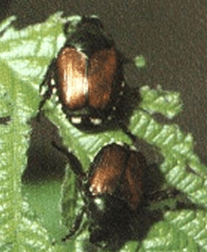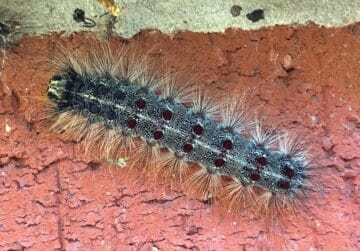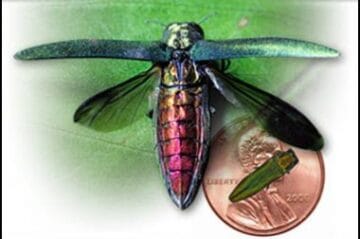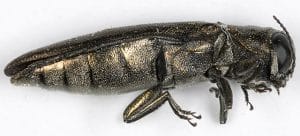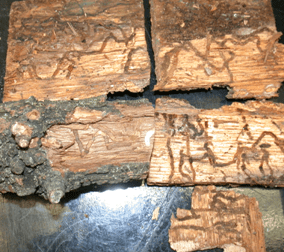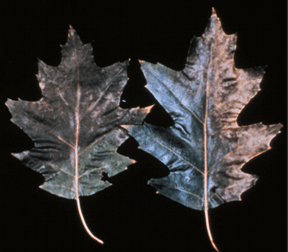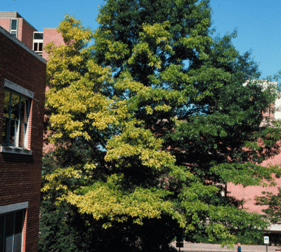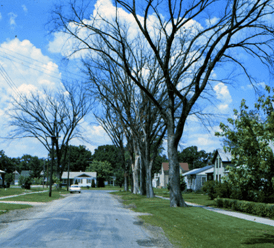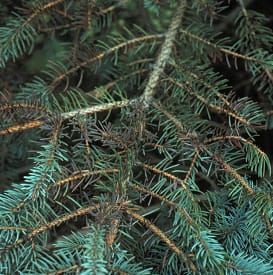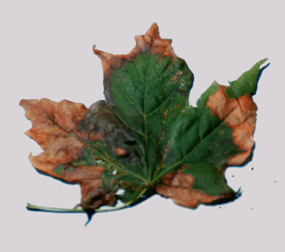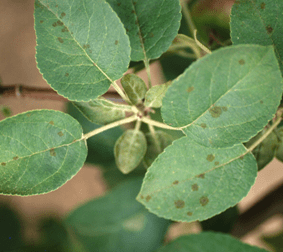Proper diagnosis by a certified Arborist is crucial to prescribing the proper treatment for your tree. Many pests and diseases exhibit the same signs and symptoms, and misdiagnosis and improper treatment can result in further damage or loss of the tree.
Our ISA Certified Arborist can come to your site to inspect any damage, signs, and symptoms of pests or disease to determine the cause of the damage to your tree. A twig or branch sample may be collected to be sent in for lab analysis for proper diagnosis. After our Arborist has determined the cause of the tree damage and has prescribed the appropriate treatment methods, our trained and certified technicians can perform the proper treatment methods to control the pest or disease to prevent further damage to the individual and surrounding trees.
Click on any of the tree pests or diseases listed below for more information.
Photo credit: University of Wisconsin Horticulture Division of Extension
Info: Japanese beetles (Popillia japonica) are an invasive, non-native, beetle that can cause significant damage to trees, shrubs, and herbaceous plants. Adult beetles have a voracious appetite and can quickly defoliate a plant or tree by eating the leaves causing major damage to the tree. If not properly treated, this could result in the loss of the tree. Younger, less established, trees are more susceptible to this pest than older, more established, trees. Early diagnosis and treatment are crucial to preventing tree loss.
Signs/Symptoms: Chew marks on leaves, lace-like skeleton looking leaves, presence of adult beetles, brown leaves, leaf loss.
Photo credit: PJ Liesch, UW-Entomology
Info: Spongy moth (Lymantria dispar), formerly known as “Gypsy Moth,” are invasive, non-native moths that have become one of the most common and destructive pests of trees in Wisconsin. The larvae, or caterpillar, feed on the leaves of the trees resulting in defoliation. Treatment of the larvae is key to preventing further damage and tree loss. Defoliation not only prevents the tree from performing the crucial process of photosynthesis, but it can also make the tree susceptible to disease and other pests.
Signs/Symptoms: Chew marks on leaves, lace-like skeleton looking leaves, presence of larvae (caterpillars), presence of insect droppings (frass) on surrounding surfaces.
Image credit: University of Wisconsin Horticulture Division of Extension
Info: First discovered in Wisconsin in 2008, Emerald Ash Borer (Agrilus planipennis) – (EAB) is an invasive, non-native beetle that is causing significant problems and the loss of many Ash trees in Wisconsin. The larvae create a D-shaped hole in the bark of the tree and feed between the sapwood and the bark disrupting the ability of the tree to move nutrients and water from the roots to the leaves which eventually results in the loss of the tree.
Signs/Symptoms: D-shaped holes in bark, S-shaped tunnels underneath bark, presence of adult beetles, yellowing leaves.
Photo credit: University of Wisconsin Horticulture Division of Extension
Info: As its name suggests, Bronze Birch Borer beetles (Agrilus anxius) are a common pest of Birch trees. The slender bodied bronze beetle is native to Wisconsin but causes significant damage to Birch trees by feeding on the vascular tissue preventing the uptake of water and nutrients to the tree from the roots. Over time, this damage can result in the loss of the tree.
Signs/Symptoms: Thinning, yellowing, and dieback of upper crown, smaller leaf size and browning of leaves, swollen ridges on the trunk and branches, small D-shaped holes in the bark.
Diagnosis: Our ISA Certified Arborist can come to your site to inspect any damage, signs, and symptoms of Bronze Birch Borers to determine whether they are the cause of the damage to your tree.
Treatment: After our Arborist has determined that the cause of the tree damage is indeed from Bronze Birch Borers, and has prescribed the appropriate treatment methods, our trained and certified technicians will perform root flare injections in order to control this pest and prevent further damage to the tree.
Photo: Two-lined chestnut borer galleries
Photo credit: University of Wisconsin Horticulture Division of Extension
Info: Two-lined Chestnut Borer (Agrilus bilineatus) is a common pest of stressed and unhealthy Oak trees. The larvae of this beetle will feed on the phloem and xylem of the tree preventing the tree from moving water and nutrients throughout the body of the tree. Over time, this results in damage and eventually the loss of the tree.
Signs/Symptoms: dead branches, discolored and/or wilting leaves,
Photo: Marginal leaf bronzing or tanning is often an early symptom of oak wilt.
Photo credit: University of Wisconsin Horticulture Division of Extension
Info: Oak Wilt is caused by a fungal infection of Ceratocystis fagacearum and is spread by Picnic beetles that are attracted to the fungus. The beetles carry the spores of the fungus from tree to tree spreading the fungal infection. Oaks in the Red Oak family and those with recent damage are most susceptible to the fungus. Early diagnosis and treatment is crucial to the survival of the individual and surrounding trees as this infection is easily spread to trees in close proximity to the affected tree.
Signs/Symptoms: wilting or dead branches, bronze, tan or dull green leaves; curling, drooping or falling leaves.
Photo: Yellowing of foliage characteristic of chlorosis.
Photo credit: University of Wisconsin Horticulture Division of Extension
Info: Chlorosis is a disorder of trees that are lacking certain important nutrients including iron and manganese. This is caused by either a lack of nutrients in the surrounding soil, or the inability of the roots to uptake the nutrients due to the high pH of soil.
Signs/Symptoms: Yellowing leaves that have green veins.
Photo: Dutch elm disease has led to the loss of the American elm as a street tree.
Photo credit: University of Wisconsin Horticulture Division of Extension
Info: Dutch Elm Disease (DED) is a fungal disease affecting Elm trees caused by the fungus Ophiostoma novo-ulmi. First introduced to North America in the 1900’s via elm logs imported from Europe, DED has greatly affected the Elm population throughout the United States.
Signs/Symptoms: Wilting & yellowing of leaves, dropping of leaves, brown streaks on branches underneath the bark that follow the wood grain.
Photo: Browning of interior spruce needles caused by Rhizosphaera needle blight.
Photo credit: University of Wisconsin Horticulture Division of Extension
Info: Needle Cast is the result of an infection of various species of the fungus Rhizosphaera, most commonly Rhizosphaera kalkhoffii. Fungal spores on the needles and branches can be spread throughout the individual tree as well as to nearby trees via rainfall, wind, and physical movement of infected branches. Early detection and treatment are crucial to preventing the spread of the infection which will ultimately result in the loss of the tree.
Signs/Symptoms: browning and loss of needles beginning on the innermost needles.
Photo: Anthracnose symptoms on maple leaf
Photo credit: University of Wisconsin Horticulture Division of Extension
Info: Anthracnose is caused by host specific fungus that survive in leaf litter. Sycamore are not the only trees susceptible to these fungi. Other tree species affected are Ash, Maple, Oak and Walnut. Although the symptoms of anthracnose are primarily aesthetic, it is important to control this infection early as continued infection can affect the overall health of the tree.
Signs/Symptoms: dead areas on leaves, irregular spots, curling or falling leaves.
Photo: Leaf spots typical of apple scab on apple
Photo credit: University of Wisconsin Horticulture Division of Extension
Info: Apple Scab is a fungal disease that affects members of the rose family including crabapples, pear, hawthorn, and apple trees. Infection can affect the appearance of the tree, as well as fruit yield. The primary species of fungus that causes Apple Scab is Venturia inaequalis. While not fatal, if Apple Scab is left untreated it can make the tree susceptible to other diseases and infections as it progresses. Species susceptible to Apple Scab are best treated preventatively before symptoms are visible.
Signs/Symptoms: Lesions on fruits and leaves, dropping of leaves.

